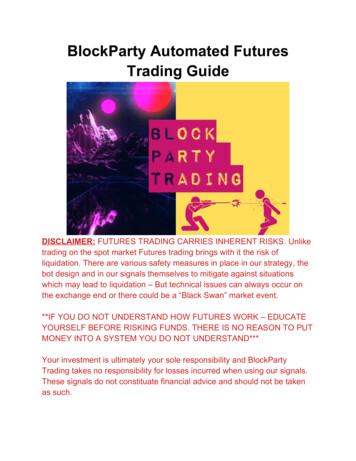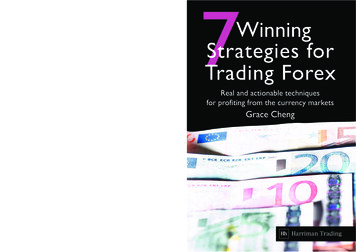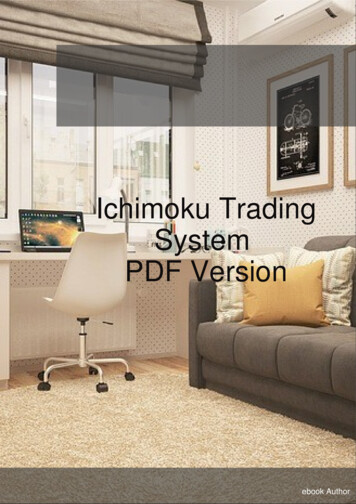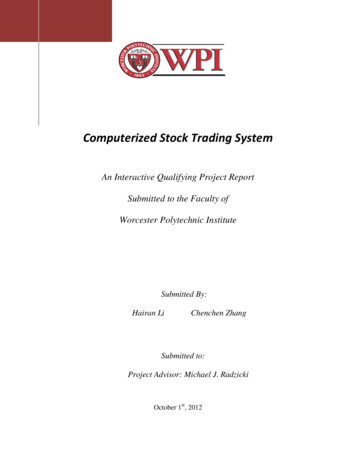
Transcription
Next
Automated trading strategies pdfAutomated trading strategies interactive brokers. Automated trading strategies that work. Ninjatrader 8 automated trading strategies. Automated trading strategies intraday. Automated trading strategies ninjatrader. Automated trading strategies pdf. Best automated trading strategies. Automated trading strategies jp morgan.Trading type using highly sophisticated algorithms and very short-term investment horizons Examples and perspectives in this article may not represent a world view of the subject. You can improve this article, discuss the subject on the discussion page, or create a new article, as appropriate. (October 2020) (Find out how and when to remove thismodel message) Financial market participants Credit Co-operatives Insurance companies Investment banks Investment funds Pension funds Pension funds brokers Investment funds Investment funds Investment funds Investment funds Investment funds Investment funds Investment funds Investment funds Investment funds Investment fundsInvestment funds Investment funds Investment funds Investment funds Investment funds Investment Funds Business Finance Personal finance Public finance Banks and banking Financial regulation High-frequency investment funds (HFT) is a type of algorithmic financial trading characterized by high speeds, high rotation rates, and high order ratiosfor trading that leverages high-frequency financial data and electronic trading tools[1] Although there is no single definition of HFT, among its main attributes are highly sophisticated algorithms, co-location and short-term investment horizons seen[2]in average , 10Ã 40% of the volume of transactions in actions, and 10Ã 15% of the volume inforeign exchange and commodities. Intraday, however, the proportion of HFT can vary between 0% and 100% of the short-term commercial volume. Previous estimates reporting that HFT accounted for 60Ã 73% of the entire volume of U.S. stock transactions, with this number falling to about 50% in 2012 were highly inaccurate speculativeassumptions[10][11] High-frequency investors enter and depart from short-term positions at high volumes and at high speeds with the aim of sometimes capturing one fraction of a dog in in all business. [6] HFT companies do not consume significant amounts of capital, accumulate positions or keep their wallets overnight. [12] As a result, HFT has apotential Sharpe relationship (a risk reward measure) dozens of times greater than the traditional strata Purchasing and detention strategies. [13] High-frequency traders usually compete against other HFTs, rather than long-term investors. [12][14][15][15] High-dimensional freight transport companies constitute the low margins with incrediblyhigh volumes of transactions, often numbered in the mills. A substantial body of research argues that HFT and commerce electronic commerce poses new kinds of challenges to the financial system. [5][16] Algorithmic and high-frequency traders were both considered to have contributed to the volatility in the Flash Crash in May 6, 2010 when highfrequency liquidity suppliers quickly withdrew from the market. [5][15][16][17][18] Several European countries proposed the reduction or banning of HFT because of concerns about volatility. [19] The feast HISTORICAL HISTORICAL HIGH-frequentncy trade has occurred at least since the 1930s, mainly in the form o f experts and traders of pokerbuying and selling positions at the physical location of the exchange, with tel o services High speed graph for other interchanges. [20] The quick-burning computer HFT gradually developed since 1983 after NASDAQ introduced a purely electronic form of negotiation. [21] At the turn of sound the 21st century, transport operations ground up ground had a period of execution of several seconds, while in 2010 this period decreased to milliseconds and up to even microseconds. [22] See ya. recently, the feast High-frequency trade was a little-known topic outside the financial sector, with an article published by the New York Times in July 2009 being one of the first to the publicattention. [23] In September 2, 2013, Italy became the first country in the world to introduce a tax specifically targeted at HFT, charging a 0.02%rate on action transactions lasting less than 0.5 seconds. [24][25] Market growth in the beginning of sound twentieth, high frequency trading still accounted for 10% of equity applications, but thisproportion was soon to begin a fast growing. According to NYSE data, the volume of negotiation grew by about 164% between 2005 and 2009 for which high frequency negotiation can be accounted for. [23] From the first quarter of 2009, the total assets under management of hedge funds with high-freight trading strategies were 141 billion, below21% of its peak Before the worst crisis, although most of the largest HFTs are actually LLCs owned by a small number of investors. The high-freight strategy was made for the first time popular by Renaissance Technologies [27] that they use the QFT and quantitative aspects in their business. Many high-freight companies are market manufacturersand provide liquidity to the market that reduces volatility and helps close offer - supply offer, making it rocio and investing cheaper for other market participants. [26] Market participation in the United States in 2009, high-freight business undertakings represented 2% of approximately 20,000 companies operating today, but represented 73% of allrequests for equity volume . [Question required] [28] The main high-freight deal of US. Companies include Virtu Financial, Tower Research Capital, BMI, Tradebot and Citadel LLC. [29] The Bank of England estimates similar percentages for the US 2010 market share, also suggesting that in Europe HFT represents about 40% of equity requestsvolume and for SIA about 5 - 10%, with rapid growth potential. [22] By value, HFT was estimated in 2010 by the Advisory TABB Group to represent 56% of US and 38% capital business in Europe. [30] As HFT strategies become more widely used, it may be more difficult to profit with profit. According to an estimate of Frederi Viens of PurdueUniversity, the hft in the U.S. are declining from an estimated peak of 5 billion in 2009 to about 1.25 billion in 2012. [31] Although the percentage of volume attributed to HFT fell on the stock markets, it remained prevalent in futures markets. According to a one In 2010, by the Aite Group, about a quarter of the world's largest volume of futurescame from high-frequency professional traders. [28] In 2012, according to a study by the TABB Group, HFT counted more than 60 percent of all future market volumes in 2012 on U.S. exchanges. [32] The trading of high frequency strategies is a quantitative negotiation characterized by short periods of portfolio hold. [33] All portfolio attributiondecisions are made by computerized quantitative models. The success of high frequency trade strategies Is driven by its ability to simultaneously process large volumes of information, something that ordinary human traders cannot do. Specific algorithms are monitored by their owners. Many pre performing algorithms are, in fact, fairly simplearbitrations that could have been carried out previously at low frequencies of bettorcompetition tend to occur through those who can perform them faster than who can create new advanced algorithms. Common types of high frequency trading include various market types, event arbitration, national arbitration, and security arbitration. Mosthigh frequency commercial strategies are not fraudulent, but exploit minute deviations from the market's balance. [33] Market production main article: Market producer according to the SEC:[34] A "market manufacturer" is a company that is ready to buy and sell a particular stock on a regular and permanent basis at a quoted public price. Oftenyou will hear about market manufacturers in the context of nasdaq markets or other "over the counter" (OTC). Market manufacturers who are ready to buy and sell listed stocks in an exchange, such as the New York Stock Exchange, are called "third-party market producers". Many units of OTC have more than one market manufacturer. In general,market producers should be ready to buy and sell at least 100 parts of a stock in which they make a market. Therefore, a large order from an investor may have to be met by several potentially different market producers. There may be significant overlap between a "market manufacturer" and the "HFT company". HFT companies characterize theiractivity as the "Market making" a priori@ a set of high-frequency commercial strategies that involve placing a limit order to sell (or offer) or a purchase limit order (or bid) in order to gain the spread of the offer request. In doing so, market producers provide counterparty to orders received on the market. Although the role of the market manufacturerwas traditionally played by specialized companies, this strategy class is now implemented by a wide variety of investors, thanks to the wide adoption of direct market access. As pointed out by empirical studies,[35] this renewed competition between liquidity suppliers causes a reduction of the actual market differentials, thereby reducing the indirect
costs for final investors. "A crucial distinction is that real market manufacturers do not leave the market at their discretion and undertake not to leave, when HFT companies are not under any similar commitment. Some high-frequency commercial companies use the market as their primary strategy.[12] Auto Trade Department (ATD) that waspurchased by Citigroup in July 2007, was an active market manufacturer, with about six percent of the total volume in both the NASDAQ and the New York Stock Exchange. [36] In May 2016, Citadel LLC purchased ATD assets from Citigroup. The construction of market strategies typically involves precise modeling of the target microstructure of themarket[37][38] along with stochastic control techniques. [39][40][41][42] These strategies seem closely related to the entry of new electronic spaces. The academic study of the entry of Chi-X into the European stock market reveals that its launch coincided with a large HFT that made markets with theNYSE-Euronext and the new market, Chi-X. Thestudy shows that the new market provided ideal conditions for the realism of the HFT market, low rates (i.e. , discounts for quotes that led to the execution) and a quick system, however, HFT was equally active in the incumbent market to unload zero-zero situations. New market market and the arrival of HFT are still demonstrated a s coincidingwith a significant improvement in liquidity supply[43] Quote reporting More information: Quote reporting The stock filling a form of abusive market manipulation that has been used by high-frequency traders (HFT) and is subject to disciplinary action. It implies rapidly entering and withdrawing a large number of orders in an attempt to flood themarket, creating confusion in the market and trading opportunities for high-frequency traders[44][45] [46] Ticker tape trading For other uses, see Ticker tape (helplessness). Turns out a lot of information Involuntably incorporated into market data, such as quotations and volumes. By observing a flow of quotes, computers are able to extractinformation that has not yet crossed the news screens. Since all quotes and volume information are public, such strata These are in full compliance with all applicable laws. The Mom Filter trade one of the most primitive strata High frequency commercial operations involving the monitoring of large quantities of stocks for changes insignificant or unusual prices or volume activity. This includes the negotiation of anecdotes, news, or other critiques rivers of events. The software would then generate an order to purchase or sell, depending on the nature of the event to be sought[47] Negotiation with ticks often aims to recognize the beginnings of large orders placed on themarket. For example, a large order from a pension fund to buy will take place for several hours or even days, and will cause a price increase due to increased demand. An arbitrage can try to detect this event and then buy the insurance, and then profit from selling it back to the pension fund. This strata It has become more difficult since theintroduction of companies dedicated to commercial execution in the years 2000 [quote] that provide a maximum [citation required] trade for funds of pensÃes and other funds, specifically designed to remove [citation needed] the opportunity of arbitration. Event arbitrage Certain recurring events generate Short-term responses in a selected set oftitles. [48] High-frequency traders take advantage of this predictability to generate short-term profits. [49] Statistical arbitration Another set of high-freight trading strategies are strategies that explore predictable temporary deviations of statistically stated relationships between tutulos. Statistic arbitration at high frequencies is actively used in allliquid titles, including equities, titles, futures, cà mbio, etc. These strategies can also involve clinical arbitration strategies, such as the parity of interest rates covered in the Cà MBI market, which gives a relationship between the pregulations of a Domestic van, a van styled in foreign currency, the spot price of the currency, and the price of afuture contract in the currency. High frequency negotiation allows similar arbitrations using higher complexity models involving many more than four tapules. The TABB Group estimates that the annual annual profits of high-frequency arbitration strategies exceeded US 21 billion in 2009, although the purdue study estimated the profits for all highfreight operations to be 5 Bilhias in 2009. [31] Arbitration inex change. If an HFT company is capable of accessing and processing information that predicts these changes before the tracker funds do it, they can buy titles in advance of the trackers and sell them in a profit. Negotiação Based on news from the company in electronic text format isavailable from many fonts, including commercial suppliers such as Bloomberg, Public News Sites and Twitter Feeds. Automated systems can identify business names, keywords and sometimes semi- news-based trades before human traders can process the news. low latency strategies a separate class, naive of high-frequency trading strategiesdepends exclusively ondirect access technology to the latency market. In these strata Computer scientists depend on the speed to obtain minimal advantages in arbitrating price discrepancies in some private insurance markets simultaneously in spar markets (demand quote) Another aspect of the strategy Low-latency power has been the changefrom fiber-optic technology to microwave technology to long-range networks. Especially since 2011, there has been a tendency to use microwaves to transmit data through Key links, like the one between New York and Chicago. This is because microwaves that travel in the air suffer a lower speed decrease than 1% in comparison to light travelingin the foreground, while with conventional optical fibers light travels more than 30%slower[31] Strategic ordering properties The strata High frequency trading strategies can use properties derived from market data to identify orders that are fixed at sub-optimal prices. Such orders can offer a profit to your counterparties that high-frequencytraders can try to obtain. Examples of these characteristics include the age of an order[50] or the sizes of the exposed orders[51] The tracking of important properties of the order can also m allow the strata Commercial strategies have a more accurate forecast of the future price of a title. Effects The effects of coma algorithmic and highfrequency traffic are the subject of ongoing research. The Mom High frequency traffic causes regulatory concerns a s a contributor to market fragility[52] Regulators claim that these practices contributed to volatility in the 6-May Flash Crash 2010[58] and consider that risk controls a r e much less stringent for faster transactions[16] Members ofthe financial industry generally complain that high-frequency trading improves The liquidity of the market, [12] reduces the supply spread, decreases volatility and makes negotiations cheaper investment for other market participants [61] a welfare study [35] discovered that for acan Large companies and in crisis markets during periods of "GeneralIncrease of the Preparations of the Actions", the Committee of High Frequency Frequency the cost of trading and increases the information of the quotas;[35]:à 31 , however, did not find "significant effects for actions of lower capitalization",[35]:à 3à and "remains open the question of whether algormic trading and the supply of algormicliquidity are equally beneficial in more turbulent or declise markets. .Algormic liquidity providers can simply turn off their machines when markets go down"[35]:à 31à In September 2011, market data provider Nanex LLC published a report stating otherwise. They analyzed the amount of price traffic compared to the value of commercialtransactions over 4 1/2 years and saw a 10-fold decrease in efficiency[6 2] The owner of Nanex à a declared detractor of high frequency trade[63] Many discussions about HFT focus only on the frequency aspect of algorithms and noto In its decision-making policy (which is kept secret by the companies that develop them). This makes it difficultfor observers to -identify ing of market trends where hft cushions or amplify price fluctuations. The growing share price compared to commercial value could indicate that more companies are trying to profit from the arbitrag e taints between markets that do not add significant value through increased liquidity when measured globally. Morefully automated markets such as nasdaq, direct edge, and BATS in the US have gained market share from less automated markets like the NYSE. Economies of scale in electronic trade contributed to lower trade and processing fees, and contributed to international mergers and consolidation of financial exchanges. The speeds of computerconnections, measured in milliseconds or microseconds, have become important[64][65] Competition is developing between exchanges for the times of faster for business completion. For example, in 2009, the London Stock Exchange bought a tech company called MillenniumIT and announced plans to implement its Millennium Exchangeplatform[66], which has a minute of 126 microseconds. [67] This allows for sub-milissecond timestamping resolution of the order book. The off-shelf software currently allows the resolution of nanoseconds of timestamps using a GPS watch with 100 nanoseconds of accuracy. [68] Spending on computers and software in the financial industryincreased to 26.4 billion in 2005.[69] May 6, 2010 Flash Crash View main article: Flash Crash 2010 The brief but damtic stock market crash of May 6, 2010 was initially thought to have been caused by high frequency trading. [70] Dow Jones Industrial Average plunge d to its biggest intraday point loss, but not a percentage loss,[71] in history, onlyto recover much of those losses in minutes. [72] In the aftermath of the accident, various organizations argued that high-frequency trading was not to blame, and may have been an important factor in minimizing and partially reversing the Flash Crash. [73] The CME Group, a major futures exchange, stated that, as the futures of the stock markettraded on the CME Group were concerned, its investigation had found no support for the news that high-frequency trading was related to the accident, and actually stated that it had a market stabilizing effect. [74] However, after almost five months of research, the U.S. Securities and Exchange Commission (SEC) and commodity futures' CommodityFutures Futures Trading Commission (CFTC) FTC) released a joint report identifying the cause that triggered the fallout from events that led to the Flash Crash[75] and concluding that the action of high-end commercial companies frequency contributed to volatility during the accident. The report found that the cause was a single sale of 4.1 billionin futures contracts by a financial fund, identified as Waddell & Reed Financial, in an attempt to raise awareness of their investment position.[76][77] The joint report also found that "high frequency traders quickly increased the impact of the sale of the mumium fund."[17] The joint report "portrayed a market so fragmented and fragile that a largebig one the market was rapidly observing the high rate of the market, which was the result of the high-frequency market, and the high-frequency market was rapidly selling the markets of the market.USA led to events of May 6, 2010 [78] Granularity and precision in 2015, the European Union Regulator based in Paris, the European Authority ofSecurities and Markets, propose standards temporals to cover the EU, which would synchronize more accurately Clocks "In a nanosecond, or a bilionà simo of a second" to refine the regulation of the Latency Latency Latency Latency Latency @ "The Speed at that trading spaces They recognize an order after receiving a request from coméccio ".Using these more detailed deadlines, regulators may better distinguish the order in which committee requests are received and executed, identify market abuses and avoid the potential manipulation of European securities markets Rivers by merchants using advanced and fast-sized computers. The most fastest technologies donating marketers anadvantage over other "slower" investors, since they can change the prices of the titles they market. [79] Risks and Controversions According to author Walter Mattli, the capacity of regulators to apply the rules has declined much since 2005 with the approval of the National Market Regulation (Reg NMS) by the Commission of furniture and US cà mbium. As a result, NYSE's almost monopolist role as holder of a market rule of actions was impaired and transformed the stock exchange into one of the many global operating exchanges. The market became more fragmented and granular, as regulating organisms, and how stock exchanges had become entities that also tried to maximize profits, theone with the most tolerant regulators was rewarded, and The survey of traders' activities was lost. This fragmentation greatly benefited the HFT. [80] High-frequency commerce includes many different types of algorithms. [1] Various studies have reported that certain types of negotiation with high frequency in the market reduce volatility and do notrepresent a systemic risk, [12] [59] [60] [74] and reduce The transaction costs for retail investors [15] [35] [59] [60] without affecting long-term investors. [6] [12] [60] [60] Other summarized in Aldridge, Krawciw, 2017[81] find strata High frequency commercial strategies known as "aggressive" and liquidity erodes and cause volatility. The Mom High frequency traffic has been the subject of intense public focus and debate since May 6th, 2010 Flash Flash At least a Nobel Prize - winning economist, Michael Spence, believes that HFT should be banned. [86] A working document found "The presence of high-frequency trading has significantly changed the frequency and severity of the finalprice shift of the day." [87] In its joint report on the 2010 Crash Flash, SEC and CFTC stated that "market manufacturers and other liquidity providers have increased their spreads, others have reduced liquidity, and a significant number has completely withdrawn from the markets" [75] during the flash ". Politicians, regulators, scholars, journalistsand market participants have all concerns on both sides of the Atlantic. [30] [84] [88] This led to the discussion of whether high-frequency market manufacturers should be subject to various types of regulations. On September 22, 2010, the speech, the President of the SEC Mary Schapiro signaled that the U.S. authorities were considering theintroduction of HFT-oriented regulations. She said: "High-frequency trading companies have a tremendous ability to affect the stability and integrity of stock markets. Currently, however, high-frequency trading companies are subject to very little in the way of obligations that protect this stability, promoting the reasonable price Continuity in difficulttimes, or to refrain from exacerbating the volatility of prices ". [89] She proposed the regulation that would require high-frequency traders to remain active in volatile markets. [90] A chair later, Chair Maria Jo White pushed against the claims that high-frequency traders have an inherent benefit in the markets. [91] Associate Director Gregg Bermansuggested that the current HFT debate has no perspective. In an April 2014 speech, Berman argued: "It is much more than just the automation of citations and cancellations, despite apparently fixingon this peak by much of the day and several market specialists. (.) I worry that it can be very closely focused and myopic. "[92] The Federal Reserveletter from Chicago in October entitled "How to keep markets safe in an era of high speed trade", reporting on the results of a survey of dozens of financial industry professionals, including traders, brokers and intercicans. [16] It found that risk controls were poorer in high frequency trade, due to the pressure of competitive time to executetransactions without the broader security checks commonly used in slower transactions. "Some companies do not have rigorous processes for the development, testing and deployment of code used in their trading algorithms." "Out-of-control algorithms were more common than predicted before the study and there were no clear standards as to theircause." The CFA Institute, a global association of investment professionals, advocated reforms related to high frequency trade,[93] including: Promoting robust internal risk management procedures and controls on the algorithms and strategies used by HFT companies. Trading spaces must disclose their rate structure to all market participants.Regulators should address market manipulation and other market integrity, regardless of the underlying mechanism, and not attempt to intervene in the trading process or restrict certain types of business activities. Flash trading Exchanges offered a type of order called "Flash" (on the NASDAQ, it was called "Bolt" on the Bat Stock Exchange) thatallowed a market lock order (post ed at the same price as an order on the other side of the book[clarification required]) for a small amount of time (5 milliseconds). This type of order was available to all participants, but as HFT adapted to changes in the structure of the market more quickly than others, they were able to use it to "skip the queue" andplace their orders before other types of were authorized to market at the given price. Currently, most exchanges do not offer flash trade, or interrupted it. In March 2011, the NASDAQ, BATS and Direct exchanges Edge had ceased to offerfor price improvement functionality (widely referred to as "flash/trading technology")[94][95] Violations and finesRegulations and Applications See also m: Regulation of algorithms in 2012, regulators fined Octeg LLC, the market unit of the company's actions Getco LLC, high-frequency service, for 450.000. The Octeg violated the Nasdaq rules and was unable to maintain an adequate oversight on its action-negotiating activities [96] The fine resulted from arequest from Nasdaq OMX for regulators to investigate activity in Octeg LLC from the day following the 2010 Flash Crash to to the following December months. Nasdaq determined that the Getco subsidiary lacked a reasonable oversight of its trade In October 2013, regulators fined Knight Capital in 12million for the commercial malfunctionthat led to its collapse. It was found that Knight violated the SEC market access rule in force since 2010 to prevent such errors. The regulators stated that HFT ignored dozens of error messages before their computers sent millions of unintentional orders to the market. Knight Capital eventually merged with Getco to form KCG Holdings. Knight lostmore than 460th million because of his commercial errors in August 2012 that caused disturbances in the US stock exchange[98] In September of 2014, HFT Latour Trading LLC agreed to pay a penalty for the 16th million dollars SEC. Latour a subsidiary of Tower Research Capital LLC, a high-frequency commercial company based in New York.According to the SEC order, for at least two years Latour underestimated the amount of risk it was taking with its commercial activities. By using the wrong coins, Latour was able to buy and sell shares without stopping enough capital. Sometimes the Tower Research Capital Subsidiary 9% of the entire US stock trade. The SEC noted that the case isthe highest penalty for a violation of the rule of net capital[99] In response to the increase in regulation, such as FINRA,[100] some[101][102] argued that, rather than promoting government governmentIt would be more efficient to focus on a solution that mitigates the asymmetries of information between traders and their financiers; Others arguethat regulation does not go far enough. [103] In 2018, the European Union introduced the MiFID II/MiFIR regulation. [104] Types of order In the twelve of January, 2015, the SEC announced a 14th Josep 160; Millions'penalty against a subsidiary of BATS Global Markets, an exchange operator that was founded by high-frequency traders. Thesubsidiary BATS Direct Edge did not adequately disclose the types of order in its two EDGA and EDGX exchanges. These exchanges offered three variety of controversial orders "Hide Not Slide"[105] and did not accurately describe their priority to other orders. The SEC considered that the exchanges disclosed full and accurat
Automated trading strategies ninjatrader. Automated trading strategies pdf. Best automated trading strategies. Automated trading strategies jp morgan. Trading type using highly sophisticated algorithms and very short-term investment horizons Examples and perspectives in this article may not represent a world view of the subject. You can improve .










